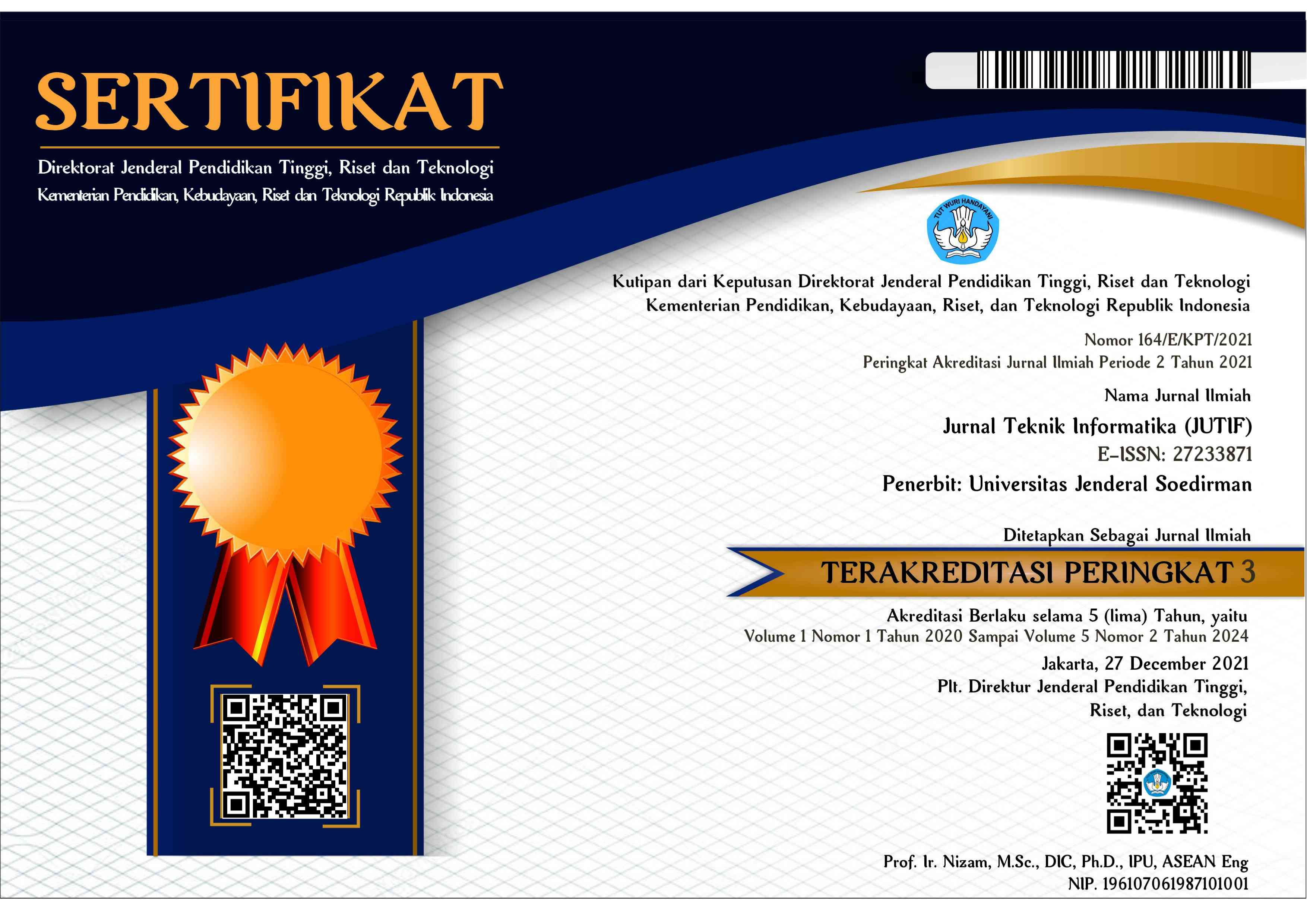INDIVIDUAL IDENTIFICATION BY IRIS USING HISTOGRAM OF ORIENTED GRADIENT (HOG) AND BACKPROPAGATION NEURAL NETWORK
Abstract
The eye’s iris biometrics is a type of biometric for individual identification that is more stable than other types of biometrics because a person's iris eye’s has a delicate fiber pattern and unique characteristics. Especially with the rapid development of the times, the need for identity recognition systems is also increasing. Introducing individuals in traditional ways is still less effective than biometric systems because, compared to conventional methods, biometric systems are safer and are not easily stolen, imitated, or accessed by any unauthorized person. In this research has been carried out by designing a simulation system for individual identification through iris eyes images using the Histogram of Oriented Gradien (HOG) method for image extraction. They were continued with classification using Artificial Neural Network (ANN) Backpropagation. The dataset used is primary data taken directly through smartphone cameras from 30 individuals.Based on the test results and analysis of the Histogram of Oriented Gradien method using an image size of 128×128 pixels, parameters of Cell Size 16×16 cells, Bins Numbers 12, Size Block 2×2 cells, L2-Hys normalization scheme, and JST backpropagation classification with Random state value 1, Learning Rates 0.001, Epoch 200, Hidden Layer 100 with the system's sigmoid activation function can produce a performance system with the most significant performance accuracy of 91.93% , using 1500 training data and 1500 iris eyes image test data.
Downloads
References
M. M. H. Ali, “Study Of Edge Detection Methods Presented by,” no. August, 2018, doi: 10.13140/RG.2.2.20662.60482.
N. D. Miranda, L. Novamizanti, and S. Rizal, “Convolutional Neural Network Pada Klasifikasi Sidik Jari Menggunakan Resnet-50,” J. Tek. Inform., vol. 1, no. 2, pp. 61–68, 2020, doi: 10.20884/1.jutif.2020.1.2.18.
J. Daugman and C. Downing, “Broken symmetries, random morphogenesis, and biometric distance,” IEEE Trans. Biometrics, Behav. Identity Sci., vol. 2, no. 3, pp. 271–278, 2020, doi: 10.1109/TBIOM.2020.2993225.
S.sujana and D. V. Reddy, “An Effective CNN based Feature Extraction Approach for Iris Recognition System,” Turkish J. Comput. Math. Educ., vol. 9, no. 1, pp. 1–5, 2021, doi: 10.17485/ijst/2016/v9i47/106827.
O. Visaliny et al., “Pengenalan Iris Mata Manusia Menggunakan Metode Klasifikasi K- Nearest Neighbor ( Knn ) Human Iris Recognition Using K-Nearest Neighbor ( Knn ) Classification Methods.”
G. S. F. Wahid, R. Purnamasari, and S. Saidah, “Identifikasi Personal Melalui Iris Mata Dengan Menggunakan Metode Compound Local Binary Pattern Dan Klasifikasi Support Vector Machine Personal Identification Based on Compound Local Binary,” JEPIN (Jurnal Edukasi dan Penelit. Inform., vol. 6, no. 2, pp. 3959–3966, 2019.
A. Rezika, Ernawati, and A. Elansari, “Identifikasi pola iris mata dengan algoritme daugman dan metode hamming distance,” Rekursif J. Inform., vol. 6, no. 2, 2018.
S. Devella, “Pengenalan Iris menggunakan Ekstraksi Fitur Histogram of Oriented Gradient,” J. Tek. Inform. dan Sist. Inf., vol. 4, pp. 124–134, 2018.
M. A. Abuzneid, A. Mahmood, and S. Member, “Enhanced Human Face Recognition Using LBPH Descriptor , Multi-KNN , and Back-Propagation Neural Network,” IEEE Access, vol. 6, pp. 20641–20651, 2018, doi: 10.1109/ACCESS.2018.2825310.
T. Surasak, I. Takahiro, C. H. Cheng, C. E. Wang, and P. Y. Sheng, “Histogram of oriented gradients for human detection in video,” Proc. 2018 5th Int. Conf. Bus. Ind. Res. Smart Technol. Next Gener. Information, Eng. Bus. Soc. Sci. ICBIR 2018, no. 2006, pp. 172–176, 2018, doi: 10.1109/ICBIR.2018.8391187.
W. Zhou, S. Gao, L. Zhang, and X. Lou, “Histogram of Oriented Gradients Feature Extraction from Raw Bayer Pattern Images,” IEEE Trans. Circuits Syst. II Express Briefs, vol. 67, no. 5, pp. 946–950, 2020, doi: 10.1109/TCSII.2020.2980557.
S. Nigam, R. Singh, and A. K. Misra, “Efficient facial expression recognition using histogram of oriented gradients in wavelet domain,” Multimed. Tools Appl., vol. 77, no. 21, pp. 28725–28747, 2018, doi: 10.1007/s11042-018-6040-3.
A. Irianti, P. H. Rantelinggi, A. Taufik, and N. Zulkarnaim, “Implementation Of Backpropagation Artificial Neural Network For Food Price Prediction In Majene Central Market,” J. Tek. Inform., vol. 3, no. 3, pp. 681–688, 2022.
U. Shruthi, V. Nagaveni, and B. K. Raghavendra, “A Review on Machine Learning Classification Techniques for Plant Disease Detection,” 2019 5th Int. Conf. Adv. Comput. Commun. Syst. ICACCS 2019, pp. 281–284, 2019, doi: 10.1109/ICACCS.2019.8728415.
J. Amrutha and A. S. Remya Ajai, “Performance analysis of backpropagation algorithm of artificial neural networks in verilog,” 2018 3rd IEEE Int. Conf. Recent Trends Electron. Inf. Commun. Technol. RTEICT 2018 - Proc., pp. 1547–1550, 2018, doi: 10.1109/RTEICT42901.2018.9012614.
R. A. Surya, A. Fadlil, and A. Yudhana, “Identification of Pekalongan Batik Images Using Backpropagation Method,” J. Phys. Conf. Ser., vol. 1373, no. 1, 2019, doi: 10.1088/1742-6596/1373/1/012049.
T. P. Lillicrap, A. Santoro, L. Marris, C. J. Akerman, and G. Hinton, “Backpropagation and the brain,” Nat. Rev. Neurosci., vol. 21, no. 6, pp. 335–346, 2020, doi: 10.1038/s41583-020-0277-3.
Copyright (c) 2023 sofia saidah, widya alisya, Iwan Iwut

This work is licensed under a Creative Commons Attribution 4.0 International License.




























